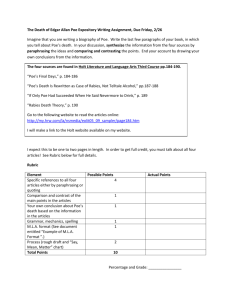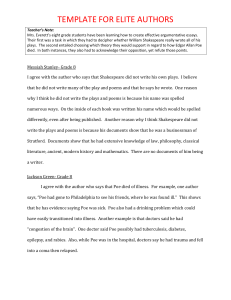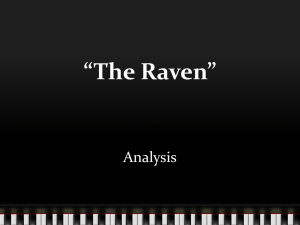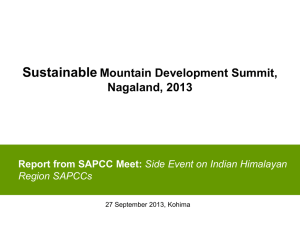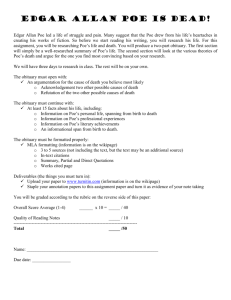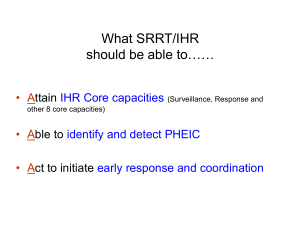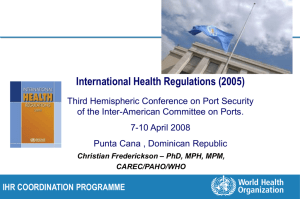Guidance for public health units about core
advertisement
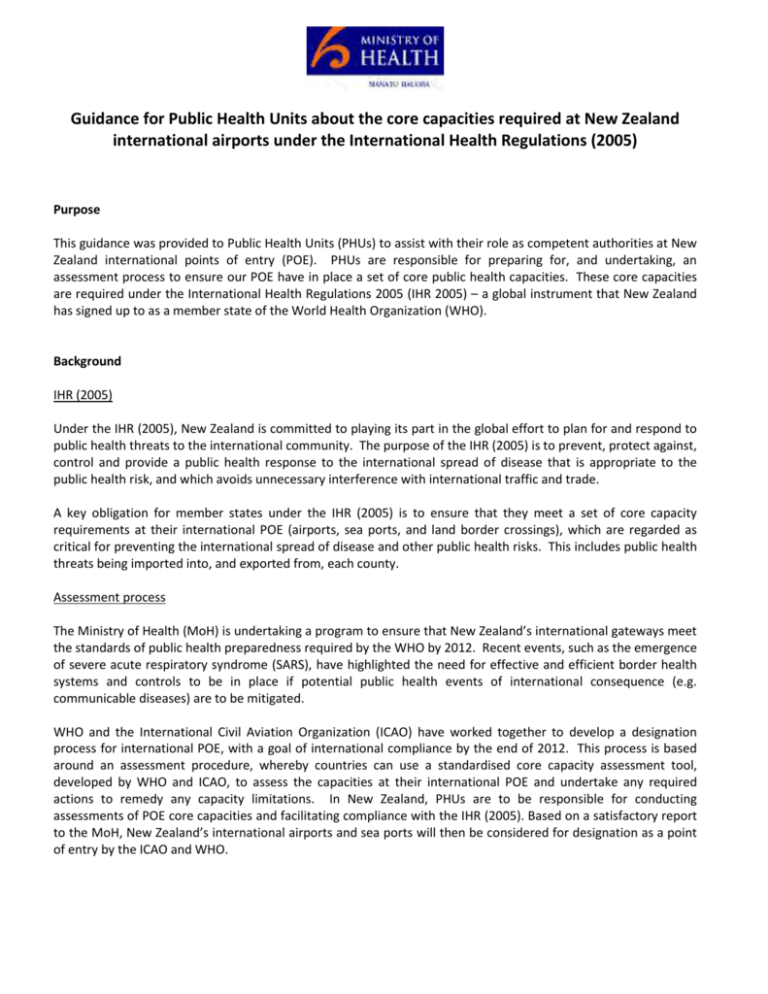
Guidance for Public Health Units about the core capacities required at New Zealand international airports under the International Health Regulations (2005) Purpose This guidance was provided to Public Health Units (PHUs) to assist with their role as competent authorities at New Zealand international points of entry (POE). PHUs are responsible for preparing for, and undertaking, an assessment process to ensure our POE have in place a set of core public health capacities. These core capacities are required under the International Health Regulations 2005 (IHR 2005) – a global instrument that New Zealand has signed up to as a member state of the World Health Organization (WHO). Background IHR (2005) Under the IHR (2005), New Zealand is committed to playing its part in the global effort to plan for and respond to public health threats to the international community. The purpose of the IHR (2005) is to prevent, protect against, control and provide a public health response to the international spread of disease that is appropriate to the public health risk, and which avoids unnecessary interference with international traffic and trade. A key obligation for member states under the IHR (2005) is to ensure that they meet a set of core capacity requirements at their international POE (airports, sea ports, and land border crossings), which are regarded as critical for preventing the international spread of disease and other public health risks. This includes public health threats being imported into, and exported from, each county. Assessment process The Ministry of Health (MoH) is undertaking a program to ensure that New Zealand’s international gateways meet the standards of public health preparedness required by the WHO by 2012. Recent events, such as the emergence of severe acute respiratory syndrome (SARS), have highlighted the need for effective and efficient border health systems and controls to be in place if potential public health events of international consequence (e.g. communicable diseases) are to be mitigated. WHO and the International Civil Aviation Organization (ICAO) have worked together to develop a designation process for international POE, with a goal of international compliance by the end of 2012. This process is based around an assessment procedure, whereby countries can use a standardised core capacity assessment tool, developed by WHO and ICAO, to assess the capacities at their international POE and undertake any required actions to remedy any capacity limitations. In New Zealand, PHUs are to be responsible for conducting assessments of POE core capacities and facilitating compliance with the IHR (2005). Based on a satisfactory report to the MoH, New Zealand’s international airports and sea ports will then be considered for designation as a point of entry by the ICAO and WHO. Pilot assessment During 2010, a pilot assessment was made of Christchurch International Airport Limited’s (CIAL) compliance with the IHR (2005) core capacity requirements. This work was led by Community and Public Health (CPH) with support from the MoH. During the pilot project, CPH worked with CIAL and key stakeholders such as conveyance operators, ground handlers, service providers, and relevant border agencies. The pilot assessment was undertaken via a staged process: MoH sent a letter to the airport authority providing a background to the IHR and the designation project as well as the projected timeline. A project proposal was submitted to CPH management for approval which considered the personnel commitment and time frame. A meeting with airport company management and key stakeholders was held outlining the IHR (2005) and the designation process being carried out. A copy of the assessment tool was given to each stakeholder and the documented standard operating procedures (SOPs) references for each stakeholder’s role were entered in the “comments” field by the stakeholder – this is referred to as the “Compliance Index/register” – it basically provides the reference for the assessor to verify compliance with that role. Time was spent determining who carried out the roles other than the major stakeholders (for example the ground handlers were not initially included). Meetings were held with the ground handlers and assessments made of compliance with the various WHO or ICAO guidelines. A second meeting was held with airport management to provide them with a summary to date and any gaps found. CIAL needed assistance with assembly of documentation. The assessment was completed and MoH and CPH met with airport management as well as Customs advising them of the outcome and outlined the major findings. Final reports were prepared for MoH, CPH management, CIAL and letters of thanks sent out to all involved in the assessment process. CPH undertook its assessment using the standardised tool developed by the WHO/ICAO, which considers the core capacities across the following three broad areas: Co-ordination, communication core capacities for event information and adoption of measures POE core capacities required AT ALL TIMES POE core capacities required during a PUBLIC HEALTH EMERGENCY OF INTERNATIONAL CONCERN (PHEIC)1. Key lessons from the CIAL pilot A summary of some of the key lessons learnt by CPH during the CIAL pilot assessment process are noted below. Note, this is not intended to be a list of everything PHUs need to know or do when assessing IHR (2005) core capacities at their international POEs, but will provide a good starting point. 1 Under the IHR (2005) a PHIEC is defined as an extraordinary event which is determined to: (i) constitute a public health risk to other States through the international spread of disease, and (ii), to potentially require a coordinated international response. 2 Sound Project Management Use a systematic assessment Process Learn and know the IHR POE Assessment Tool. Use a staged approach, planned out over reasonable time frames (see CPH approach above). A sound assessment requires detailed planning up front. Read the IHR and take time to learn and understand the IHR core capacity assessment tool. For example, while there might appear to be some overlaps in the assessment tool, they are there for a reason (e.g., Section C2: Training for inspectors and Section D2: Inspection programmes of the ‘capacities at all times’ spreadsheet have similar looking line items, but one is focused on the training of inspectors while the other on the programmes themselves). WHO has developed a paper on the assessment tool and an electronic Excel Speadsheet version is available from the WHO website (see the references section below). Be confident in its application, but seek advice from the MoH or your colleagues from other PHUs on interpretation if needed. Develop a Compliance Index/register up front (see CPH’s model). Pool information and experiences across the PHU. Ensure peer support and review when needed. Understand the POE operational environment Physical attributes of the POE: (Refer to assessment tool for comprehensive list) Know the different organisations that operate and their roles (Refer to response plan for comprehensive list) Recognise the different perspectives, view points, and drivers (while not losing sight of core public health considerations) Upskilling and informing POE operators on key health issues Know the core physical location of the key parts of POE (e.g., the first aid room and capacity to separate/treat travellers, the Airport Fire Service/Emergency Service, location of agencies offices, waste points, food premises, etc). Look for opportunities to influence POE design from a health perspective (e.g., non touch taps). The Airport Company – Know what it does and how it operates (e.g., reliance on a range of sub-contractors to do components of the core capacities)? What contractors are used for different functions (water and waste, vector, cleaning, etc)? There may be more than one subcontractor doing the same role (e.g., CIAL had three different ground handling companies). You need to be realistic – a balanced approach is needed between protecting public health and recognising the commercial imperatives that operate in the transport/traveller focussed point of entry. Time is money – delaying or interfering with transport and trade without a sound and justifiable reason will cause problems for all. Be sensitive to time demands on operators during the assessment process. Some core areas include cleaning, sanitation verification, water and waste verification, integrated vector control, correct use of personal protective equipment, etc. Try to find common ground or show how a health outcome is relevant to POE’s business or can add value (e.g., travellers expect clean and sanitary conditions and will judge POE on such things). Clearly defining and agreeing key partners’ roles and responsibilities and agreed response procedures Develop a common understanding of who is responsible for each IHR core capacity Commencing development of compliance register/index. Start to develop a Task Matrix to allocate responsibility to the required tasks, (see attached example of a Task Matrix). Roles should be defined, agreed to, and clearly documented. Recognise links with partners outside the POE environment (e.g., NZ’s IHR National Focal Point is the Director of Public Health in the MoH. PHU staff need to understand what the role of the NFP is and the reporting pathway (HPO, Medical Officer of Health, Director of Public Health, WHO). 3 PHU staff need to ensure there is clinical input/support into decision-making, risk assessment and disease management. If in doubt about who should be responsible for any core capacity, raise the issue with the MoH. PHU’s Relationship building, establishing and maintaining trust and confidence with POE stakeholders Integrate with existing fora/committees at POEs Face to face contact with key stakeholders is vital Robust communications networks to allow timely dissemination of health information to all stakeholders Actively seek involvement with existing airport standing committees to promote health issues – especially Health and Safety Committees where a wide range of stakeholders will be present. Use these opportunities to brief stakeholders on IHR POE core capacity requirements and to get health issues on the table or offer advice and support (e.g., delivering of PPE training, basic training tool on infection control key points, etc). Continue networking via other channels outside such standing groups. Meet people, remember their names, confirm their details, and understand their roles Spend time with them (e.g., ground handlers). Tap into the existing communications networks at POEs and respond promptly when asked for input. Determine the most appropriate communication channels in POE (e.g., essential training to border agencies and operators – such as recommendations for the use of PPE). Undertake the Assessment Verification tips Pre-assessment engagement helps pave the way (informal). Develop checklists of the key questions to ask (discuss with CPH about what they did). Try to involve PHU staff with skills in auditing or undertaking assessments. Populate the assessment tool, but don’t reinvent the wheel – e.g., in many places you can populate the tool with simple cross references to other existing documents and tools, which adequately cover off issues (PHRMP for water supply, Airport Response Plans, etc). Obtain copies of relevant SOPs during the assessment, or other documented proof to give you greater assurance that a core capacity is being met. Just because a procedure is documented doesn’t mean it is being complied with, do not assume anything, – additional checks could be needed (e.g., ask for a recent example to show it was followed). Initiate multi-agency training/upskilling Confirming response plan Competencies and capacities for PHU assessors Provide the completed assessment tool to key stakeholders and seek feedback. Identify and rectify gaps and overlaps. Consult guidance provided by WHO/ICAO and other international agencies in relation to the IHR (2005). Work with POE to develop action plans to remedy deficiencies or weaknesses found in the assessments (review progress and at appropriate intervals). Confirm that deficiencies found by the assessment tool are remedied. Communicate major findings or concerns about progress to the Ministry. Skills in audit processes and good knowledge of communicable diseases and infection control. Core Environmental Health competencies e.g. drinking water, waste, food, vector control. CPH found a team approach worked best (rather than one person) – brings a suite of skills, enables internal peer review, helps ensure knowledge and skill retention). Reality check the assessment with the POE community 4 Further advice and guidance PHUs wanting further advice from the MoH about the IHR (2005) or the programme to assess core capacities at New Zealand POE can contact: JR Gardner, Environment and Border Health Team; Mob: 0212413582; email: john_gardner@moh.govt.nz Further information from CPH staff involved in the CIAL pilot about their experiences, assessment process used, and key lessons learned. Debbie Smith - DDI: (03) 3786780 email: Debbie.Smith@cdhb.govt.nz or Paul Schoolderman: DDI: (03) 3786723 email: Paul.Schoolderman@cdhb.govt.nz. WHO Guidance WHO’s IHR Assessment Tool for core capacity requirements at designated airports, ports and ground crossings (October 2009). Available at: www.who.int/ihr/ports_airports/en/ (DRAFT) Guidance for Public Health Emergency Contingency Planning at Designated Points of Entry: Requirement under the International Health Regulations (2005). Note, this document has been developed via the WHO's Western Pacific Regional Office and is still in 'draft status' while it awaits publication by WHO. The document contains useful guidance and PHUs wanting to read a draft copy should contact: john_gardner@moh.govt.nz. WHO’s Guide to Hygiene and Sanitation in Aviation (2009). Available at: www.who.int/water_sanitation_health/hygiene/ships/en/ ICAO, Airlines Council International (ACI) and International Airline Transport Association (IATA) resources Guidelines for states concerning the management of communicable disease posing a serious public health risk – 2009. Available at: www.icao.int/icao/en/med/guidelines.htm Airport preparedness guidelines for outbreaks of communicable disease - April 2009. Available at: www.aci.aero/aci/aci/file/ACI_Priorities/Health/Airport%20preparedness%20guidelines.pdf Additional Guidance can be sourced from the Cooperative Arrangement for the Prevention of the Spread of Diseases through Air Travel, (CAPSCA) www.capsca.org/. 5
